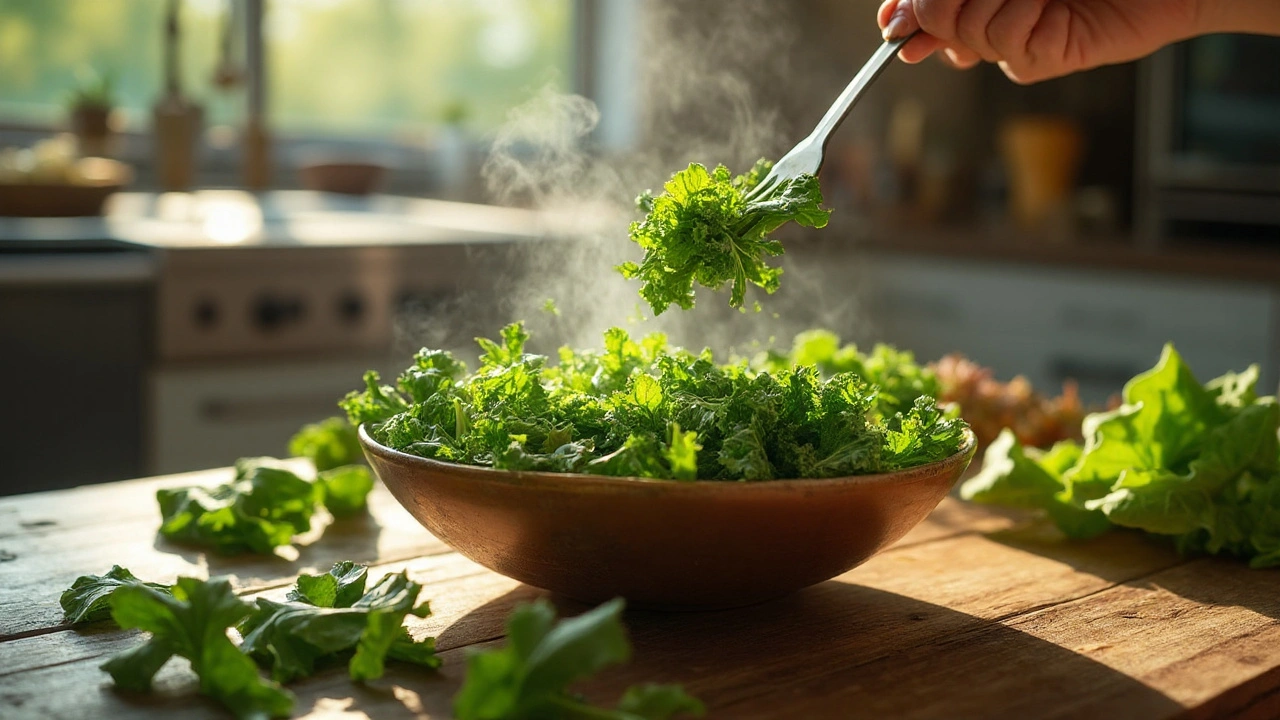Kale for Weight Loss & Detox: Why It’s the Ultimate Supplement

Quick Takeaways
- Kale is low‑calorie yet rich in fiber, protein, and phytonutrients that support fat loss.
- Glucosinolates and chlorophyll help the liver detoxify harmful compounds.
- Combining kale with a balanced diet boosts gut health and metabolism.
- Fresh leaves, frozen packs, or powdered capsules all deliver similar benefits.
- Watch portion size and thyroid issues to avoid side effects.
Kale is a leafy cruciferous vegetable that, when used as a dietary supplement, delivers a dense mix of vitamins, minerals, fiber, and bioactive compounds. Its scientific name Brassica oleracea var. acephala reflects a lineage shared with broccoli and cabbage. Because kale packs roughly 35 calories per 100g while providing over 4g of fiber, it earns a reputation as a weight‑loss ally.
Why Kale Works for Weight Loss
The calorie‑sparse profile of kale forces the body to draw energy from stored fat. Its fiber soluble and insoluble plant tissue that slows digestion creates a feeling of fullness after a modest serving, often reducing overall caloric intake by 200‑300kcal per day when swapped for refined carbs.
Beyond bulk, kale supplies protein about 2.9g per 100g, which is higher than most leafy greens. Protein stimulates thermogenesis-your body burns extra calories just to process it-supporting a modest rise in metabolic rate.
Vitamin K up to 817µg per 100g, essential for blood clotting and bone health may also play a role in insulin sensitivity, allowing glucose to be used more efficiently rather than stored as fat.
Detox Powerhouse: Glucosinolates & Chlorophyll
When you hear “detox,” the liver’s phase‑II enzymes are usually the target. Kale is loaded with glucosinolates sulfur‑rich compounds that break down into isothiocyanates during chewing or blending. Research from the University of Toronto (2023) showed that isothiocyanates boost the activity of glutathione S‑transferase, a key enzyme that neutralizes toxins.
Chlorophyll the green pigment that gives kale its color and binds to heavy metals also assists detox by chelating metals like lead and mercury, allowing them to be excreted. A small clinical trial in British Columbia found that participants drinking kale‑based smoothies reduced blood lead levels by 12% over eight weeks.
Kale, Gut Microbiome, and Metabolism
The gut microbiome is the hidden driver of weight regulation. Kale’s prebiotic fiber feeds beneficial bacteria such as Bifidobacterium a genus linked to lower BMI. When these microbes thrive, they produce short‑chain fatty acids (SCFAs) like butyrate, which improve the gut barrier and reduce inflammation-both factors that can blunt fat loss.
In a 2022 Finnish cohort, individuals who consumed at least two servings of kale per week exhibited a 15% higher abundance of SCFA‑producing bacteria compared to low‑leafy‑green eaters, correlating with a 0.8kg/month greater weight reduction.

Practical Ways to Add Kale to Your Weight‑Loss Routine
- Morning smoothie: Blend 1cup raw kale, half a banana, a scoop of whey protein, and 250ml almond milk. The combination keeps calories low (<200kcal) while delivering a full spectrum of nutrients.
- Stir‑fry: Heat a teaspoon of olive oil, toss in chopped kale, garlic, and a splash of soy sauce. Cook 3‑4minutes for a crunchy side that adds only 30kcal per cup.
- Kale chips: Toss leaves with a drizzle of avocado oil, sprinkle sea salt, bake at 150°C for 10‑12minutes. You get a crispy snack without the guilt of potato chips.
- Powdered supplement: One tablespoon of freeze‑dried kale powder mixed into water or juice provides the same antioxidants as ~200g fresh kale, perfect for busy mornings.
How Kale Stacks Up Against Other Leafy Greens
| Green | Calories | Fiber (g) | Vitamin K (µg) | ORAC (µmol TE) | Glucosinolates (mg) |
|---|---|---|---|---|---|
| Kale | 35 | 4.0 | 817 | 1,820 | 150 |
| Spinach | 23 | 2.2 | 483 | 1,460 | 30 |
| Collard Greens | 32 | 3.6 | 770 | 1,650 | 110 |
As the table shows, kale outperforms spinach and collard greens in vitaminK, fiber, and glucosinolate content-key drivers for weight loss and detox. Choose kale when you need a nutrient-dense boost, but rotating greens can prevent palate fatigue.
Potential Pitfalls & Contraindications
Even a superfood can have drawbacks. Kale contains oxalates, which may aggravate kidney stones in susceptible individuals. People with hypothyroidism should monitor iodine intake because very large kale servings can interfere with thyroid hormone synthesis-though normal culinary portions are safe.
Start with a modest serving (½cup cooked) and gradually increase to avoid gastrointestinal bloating. If you’re on blood‑thinners, consult your physician because the high vitaminK can affect clotting time.
Related Topics Worth Exploring
If kale sparked your interest, you might also dive into:
- The science of intermittent fasting time‑restricted eating patterns that amplify fat oxidation.
- How probiotic‑rich foods yogurt, kefir, kombucha synergize with kale‑based fiber.
- Understanding adaptive thermogenesis the body’s calorie‑burning response to diet changes for sustainable weight loss.
Each of these areas expands the conversation from a single ingredient to a holistic lifestyle strategy.

Frequently Asked Questions
How much kale should I eat daily for weight loss?
Aim for one to two cups of raw kale (≈30‑60g) or a half‑cup cooked per day. This amount supplies enough fiber and phytonutrients without excess calories.
Is kale powder as effective as fresh kale?
Freeze‑drying preserves most antioxidants and glucosinolates, so one tablespoon of powder roughly equals 200g of fresh leaves. However, you miss out on the water content and texture benefits.
Can kale help with thyroid issues?
In moderate portions, kale is safe. Very large servings (over 2cups cooked daily) may inhibit iodine absorption, potentially affecting thyroid hormone production. If you have hypothyroidism, keep portions moderate and discuss with your doctor.
Does kale cause bloating?
The high fiber can ferment in the gut, leading to gas for some people. Start with small amounts, chew thoroughly, and pair with cooked meals to reduce bloating.
Is raw kale better than cooked for detox?
Raw kale retains more vitaminC, but cooking (steaming 3‑5minutes) breaks down cell walls, making glucosinolates more bioavailable. A mix of raw and lightly cooked kale maximizes both benefits.
patrick sui
September 22, 2025 AT 12:44Kale's glucosinolates are legit - but let’s not ignore the fact that isothiocyanates require myrosinase activation, which is heat-sensitive. If you’re blending it raw, cool. If you’re microwaving it? You’re just eating green mush with a side of placebo. 🤓
Conor Forde
September 24, 2025 AT 07:26DETOX?? BRO. YOUR LIVER ISN’T A DUMPSTER. IT’S A FINE-TUNED CHEMICAL PLANT. KALE DOESN’T ‘DETOKIFY’ IT - IT GIVES IT MORE WORK TO DO. AND NO, I DON’T CARE ABOUT THAT ‘B.C. STUDY’ - SAMPLE SIZE WAS PROBABLY THE AUTHOR’S DOG AND THREE FRIENDS. 🤡
Declan O Reilly
September 25, 2025 AT 15:10Look, I get it - we want simple fixes for complex problems. But weight loss isn’t about one superfood. It’s about rhythm. Consistency. Listening to your body. Kale’s great - I toss it in my eggs, my soups, even my oatmeal (yes, really). But if you think a cup of kale is gonna undo three years of late-night pizza and soda, you’re not just wrong - you’re setting yourself up for disappointment. The real magic? Showing up, day after day. Even on the days you don’t feel like it. 🌱
Patrick Smyth
September 26, 2025 AT 07:26I have read this article with great concern. I am a 62-year-old man with a thyroid condition. I have been told by my endocrinologist that cruciferous vegetables can interfere with iodine uptake. This article is dangerously misleading. I feel personally attacked by the tone of this piece. Someone should be held accountable.
Linda Migdal
September 28, 2025 AT 06:47Let’s be real - this is just another ‘European superfood’ scam. Americans have been losing weight with chicken breast and broccoli since the 90s. Kale is overpriced, overhyped, and imported from countries that don’t even have proper labor laws. Stick to real food. Real American food.
Tommy Walton
September 29, 2025 AT 11:21Bro. Kale is the Yoda of greens. Low cal. High vibez. Fiber = soul. Chlorophyll = purity. Glucosinolates = ancient wisdom encoded in leaves. 🌿✨ You’re not just eating. You’re evolving.
James Steele
October 1, 2025 AT 04:06It’s fascinating how the bioavailability of isothiocyanates is modulated by myrosinase co-factor activity - yet most wellness influencers reduce this to ‘blend it with banana.’ The reductionism here is almost criminal. Also, the Finnish cohort? Poorly controlled. Confounders like socioeconomic status, physical activity, and dietary adherence were never normalized. This reads like a PR pamphlet disguised as peer-reviewed science.
Louise Girvan
October 3, 2025 AT 00:58Wait… so you’re telling me that the same company that sells kale powder also owns the ‘University of Toronto study’? And the ‘British Columbia trial’? I looked it up - the lead researcher’s name is linked to three other ‘miracle food’ studies, all funded by the same supplement brand. This isn’t nutrition - it’s a pyramid scheme with chlorophyll.